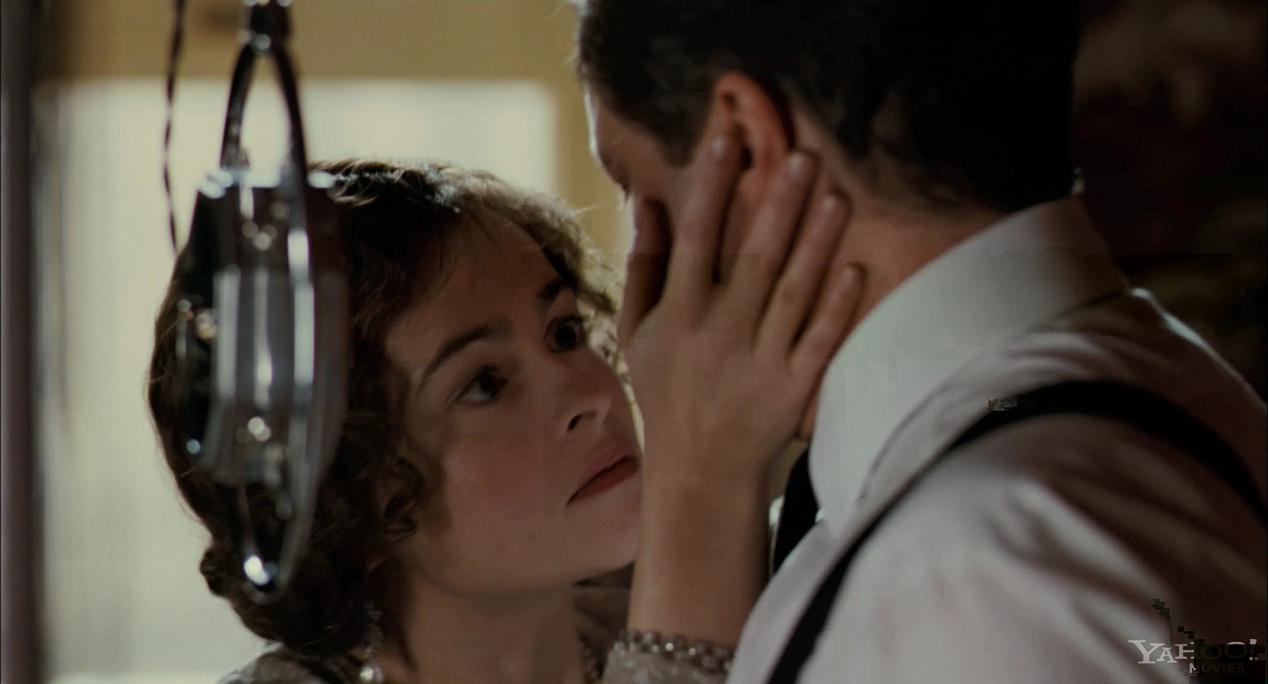 |
| "The Microphone" Bertie, The Duke of York (Colin Firth) |
In Act I, "the setup," of The King's Speech, the audience is introduced to Bertie, the Duke of York, and his growing fear of speaking publicly. In the beginning, Bertie's fear is clearly shown when he has to give a speech at an event and is unable to deliver smoothly. In the next scene, it is revealed that he stammers and sadly, Bertie believes that he just have to accept his problem. However, his wife, Elizabeth (Helena Bonham Carter), is determined to help Bertie overcome this obstacle. Therefore, she seeks out Lionel Logue (Geoffrey Rush), a speech therapist and stage actor. In the photograph above, called "The Microphone," the dominant in the screen is Bertie and his fear of the microphone (not in focus). The spatial distances between Bertie and the microphone is strained and the audience can notice that Bertie does not want to confront his fears. Despite Bertie's protests, Lionel suggests to Bertie that he should place some earphones and speak. Reluctantly, Bertie submits to Lionel's wishes, but gives up half way into the speech. While listening to the record at home, Bertie notices that he did not stammer and goes back to Lionel for more help.
 |
| "Practice Makes Perfect" (Elizabeth, The Duchess of York-Bonham Carter, Bertie, and Lionel Logue-Rush |
When Bertie finishes his story, Lionel makes the assertion that Bertie can still overcome his obstacle, but it will not be easy. The film revels the common techniques that were used to overcome this problem like: strengthening Bertie's diaphragm by not smoking and getting him to sing when he has trouble forming the words.
By the time Act III, "the resolution," begins Bertie's brother, King David, abdicates the throne and Bertie becomes King George VI. Now with this new weight on Bertie's shoulder, he is more worried about his stammer because he might be called "King George the Stammer." Therefore, Bertie's biggest test is giving his wartime speech, which will be aired throughout the British Empire. In the photograph below, called "You can do it," Elizabeth re-assures Bertie that he can do this speech perfectly. Her perseverance and love for him helped Bertie overcome his obstacle. In contrast to the first picture, the proxemic between the microphone and Bertie is no longer strained, but personal. By this point in the film, Bertie and Lionel have come a long way in making progress. Besides his wife, Lionel is the only person who knows about Bertie's past and embodies a trusted friend/colleague. Even though offscreen, Lionel is on the opposite side giving his friend encouragement and more importantly, helping him deliver the speech. Ultimately, Bertie delivers the speech perfectly without stammering.
 |
| "You can do it" King George VI and The Queen Consort Elizabeth |
Overall, the relationship between Bertie and Lionel was crucial for Bertie to succeed. Therefore, not only does Bertie overcome his speech impediment, he also delivers one of the most famous speech of all time. Therefore (in my opinion), I believe the two most important scenes that help strengthen Bertie and Lionel's friendship occurs when Bertie told Lionel about his childhood (Act II) and before the coronation. This scene is crucial because Bertie is finally able to let someone in and develop trust. Even Bertie acknowledges that him telling Lionel that he knows so little of the common man's life and vice versa. The next important scene occurs when Bertie and Lionel were practicing for the coronation. It is in this scene that Lionel pushes Bertie by seating in St. Edward's chair and Bertie tells Lionel to get out. Consequently, Lionel says, "Why should I listen to you?" Amazingly, Bertie replies by shouting (without stammering) "..because I have a right to be heard. I have a VOICE!" This scene is significant because Beritefinally takes hold of his voice and projects it with an authority tone. Hence, Bertie has come out of his shell as a small spoken person to a soon to be King with authority.
I agree with your choice of important scenes, as both are major turning points in the movie. I also liked your emphasis on the microphone’s proxemics. In the first picture, it looks like the microphone is going to push Bertie out of the frame. I think this is interesting because, like you said, the microphone is out of focus, which makes Bertie the dominant. Here, the subsidiary contrast is threatening to overcome the dominant, which creates an interesting visual. The third photo of Bertie and his wife shortly before the final speech also produces an interesting relationship with the microphone. While the microphone is still hovering near and out of focus, Bertie’s wife is the dominant. However, instead of pushing Bertie out of the frame, her hands hold him inside it. Additionally, her hand also forms a protective boundary between Bertie and the microphone. This shows that, while the microphone is still a source of anxiety, it does not hold the power it once did.
ReplyDelete